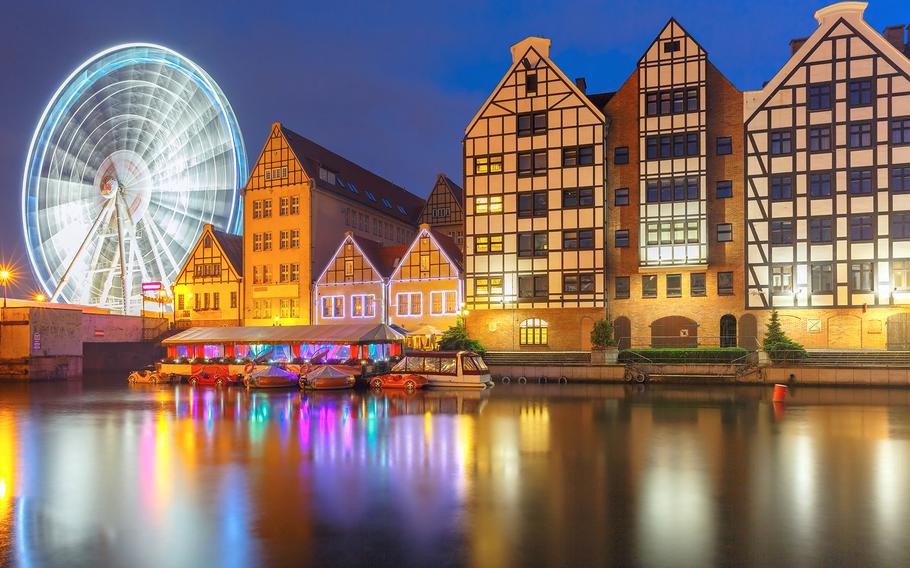
St Dominic’s Fair in Gdansk is one of Poland’s biggest summer events. It runs July 26-Aug. 17. (iStock)
As much of Europe withers under an unrelenting sun, thoughts of a holiday along the Mediterranean seacoast are enough to make one break out in sweat. When soaring temperatures make conventional vacation paradises such as Italy or Spain uncomfortable propositions, trips to one of Europe’s northern coastlines are worthy of consideration.
While the term “Baltic states” refers to the three countries of the former Soviet Union— Estonia, Latvia and Lithuania — other countries with territory bordering the Baltic Sea include Denmark, Finland, Russia, Poland, Sweden and Germany. Here’s a look at some summer events taking place in cities either directly on the Baltic coast or in close proximity to it.
Tallinn, Estonia: Tallinn Maritime Days allows visitors an up-close look at vessels of all kinds, many of which welcome guests on board. Land-based activities including concerts and a play area for children are spread across three different venues, including the Old Harbor. Maritime Days take place July 11-14; entry is free. Online: tallinnamerepaevad.ee
Tallinn’s Old Town center is also worth a look-in, as this same weekend is given to a celebration known as Medieval Days. At its center is a market attracting vendors from the Baltic region and beyond. Jousting knights and swordfighters are also figure into the programming offered July 11-13. Online: medievaldays.ee/en
Pori, Finland: This small city sits on the edge of the Gulf of Bothnia, the Baltic’s northern arm between Finland and Sweden. The city enjoys outsized name recognition through its hosting of Pori Jazz, an annual music festival with a lineup of artists in styles far beyond the confines of traditional jazz. This year’s headliners include Roxette, Sting, Tower of Power, Ultra Bra and Gregory Porter, among others. Although tickets are needed to see the top names, organizers note that some 70% of its programming is offered to the public free of charge. This year’s edition of Pori Jazz runs July 17-19. Online: porijazz.fi
Klaipeda, Lithuania: The country’s largest port city celebrates its maritime identity each year with the Sea Festival, a mix of nautical-themed events and performances. From July 25-27, up to half a million visitors are expected to join in Jūros šventė’s family-friendly festivities including concerts, street artists, a marketplace and more. Dozens of majestic sailing vessels docked in the harbor make for a postcard-perfect backdrop. Online: tinyurl.com/a29fapck
Gdańsk, Poland: St Dominic’s Fair, also referred to as the Gdańsk Wonders Festival, bills itself as one of the country’s major summer events. The programming for each year’s edition is unique. This year’s focus is on the past meeting up with the present, brought to life through imagined encounters between historical characters and present-day heroes. Over the festival’s three-week run, visitors can take in concerts and street arts, ride on attractions, shop for unique handcrafted goods and sample world cuisines or local specialties. Other offerings include an island given to jazz music, an open-air cinema, and a stage on which operetta excerpts are performed. The festival runs from July 26-Aug. 17. Online: jarmarkswdominika.pl/en/program
Gotland, Sweden: The Baltic’s largest island is Gotland, located some 55 miles off the southeast coast of Sweden. With its cobblestone streets and ancient cathedral, its largest city of Visby lends itself ideally as the backdrop to a historical festival. For eight days in late summer each year, the island celebrates Medeltidsveckan, or Medieval Week. Each year’s festival works around a certain theme, and in 2025, the importance and availability of water in the Middle Ages is explored. While many visitors turn up in medieval-style clothing to experience activities such as concerts set in church ruins or jousting tournaments, it’s not required. Other things to do include taking courses in traditional crafts, exploring a historical encampment or watching jesters entertain. Many visitors elect to stay in a modern campground offering all the comforts of contemporary life. Medieval Week takes place from Aug. 3-10. Online: medeltidsveckan.se/en
Rostock, Germany: A taste of maritime life is offered by Hansa Week, one of the world’s largest meet-ups for traditional sailing vessels. Both inexperienced landlubbers and seasoned sailors are bound to be impressed by the majestic sailing vessels, many of which can be boarded. Regattas give the chance to witness the ships in action. Land-based activities include concerts featuring South American rhythms or drum corps. To experience sailing firsthand, it’s possible to book excursions; the cost of a three- to four-hour outing begins at around 65 euros. Overnight stays on board some vessels are also possible. Hansa Sail runs Aug. 7-10. Online: hansesail.com
Riga, Latvia: With its tidy medieval Old Town and abundance of art nouveau architecture, Latvia’s capital is worth a visit any time; another reason to come is for the Positivus Festival, one of the region’s major music events. The festival is set on a sparsely inhabited green island in the Daugava River that’s within easy walking distance to the city center. This year’s headline acts at the Aug. 8-9 event include Mura Masa, Rag‘n’Bone Man, Elderbrook, Milky Chance and others. Tickets to both days of the festival cost 65 euros plus fees. Online: positivusfestival.com/en